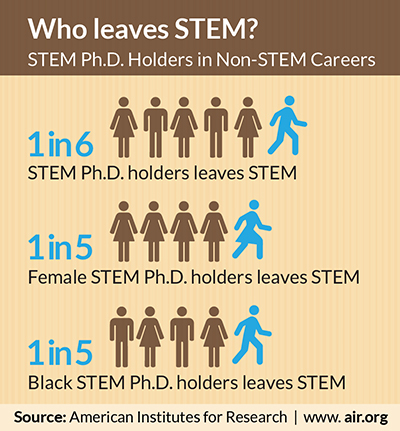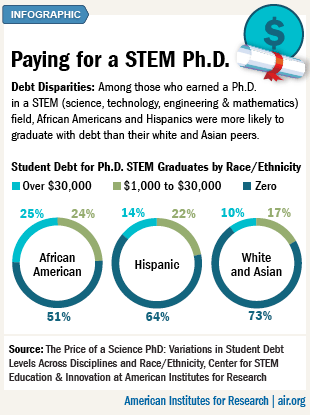Broadening Participation in STEM (Science, Technology, Engineering, and Mathematics)

Science, technology, engineering, and mathematics (STEM) degree production in the U.S. is not keeping pace with the demand for STEM talent. As a nation, our STEM education and workforce development infrastructure have realized a poor return on investment. Women, racial and ethnic minorities, and persons with disabilities are underrepresented in the STEM disciplines—the largest untapped STEM talent pools in the United States.
AIR deploys its deep expertise to help ensure access and equity to emerging STEM careers. Through research and practice, we work to ensure that STEM outreach and support systems are efficient, build skills competence, and maximize the potential of all students, especially those who are underserved in these fields, including women of all races and ethnicities, underrepresented minorities, those living in high-poverty communities, and those with disabilities.
Key Work
Identifying and Reducing Gender Bias in STEM: Systematically Synthesizing the Experimental Evidence (Project)
Researchers are debating whether biases against women in STEM have reduced over time, persist in nearly all training and career contexts, or vary in more nuanced ways across contexts and STEM fields. AIR is synthesizing four decades of research to understand the postsecondary and workforce contexts in which bias against women in STEM remains especially pernicious and the interventions that can most effectively reduce such biases.
Analyzing the Research on Gender Stereotypes in STEM (Project)
For over 25 years, scientists have studied the impact of children’s gender stereotypes about abilities in STEM. AIR experts are conducting a meta-analysis of the existing research for a National Science Foundation study seeking to clarify ambiguous findings regarding gender stereotypes in the STEM fields.
 Associations Between Predictive Indicators and Postsecondary Science, Technology, Engineering, and Math Success Among Hispanic Students in Texas (Report, 2017)
Associations Between Predictive Indicators and Postsecondary Science, Technology, Engineering, and Math Success Among Hispanic Students in Texas (Report, 2017)
Nationwide, Hispanic students continue to be underrepresented among students who complete a four-year degree in science, technology, engineering, and math fields and among workers in those fields. This study, which used data on seven cohorts of Texas students, suggests the importance of Hispanic students taking rigorous high school math and science courses.
Video: Supporting STEM in Rural Contexts
According to the Committee on Education and the Workforce, well-executed STEM programs in rural communities could have significant reciprocal benefits, enhancing the lives of students and strengthening the communities themselves. This REL Midwest webinar describes the partnerships and strategies that can help to establish a thriving rural STEM ecosystem.
STEM 2026: A Vision for Innovation in STEM Education (Report, 2016)
This report summarizes the results of discussion-based workshops where 30 experts and thought leaders in STEM teaching and learning were invited to exchange ideas and develop recommendations for the future of STEM education, an aspirational vision—“STEM 2026”—for STEM education to promote lifelong learning among all youth and in all communities.
STEM Training and Early Career Outcomes of Female and Male Graduate Students: Evidence from UMETRICS Data Linked to the 2010 Census (Journal Article, 2016)
Women are underrepresented in science and engineering, with the underrepresentation increasing in career stage. This May 2016 article from the American Economic Review analyzes gender differences at critical junctures in the STEM pathway—graduate training and the early career—using UMETRICS administrative data matched to the 2010 Census and W-2s.
Exploring the Foundations of the Future STEM Workforce: K–12 Indicators of Postsecondary STEM Success (Report, 2016)
Despite being the nation's largest racial/ethnic minority, Hispanics are underrepresented in STEM—both in college and the workplace. This REL Southwest report reviews the research to identify K–12 factors that predict students' postsecondary STEM success, particularly for Hispanic students.
Gender Differences in Science, Technology, Engineering, and Mathematics (STEM) Interest, Credits Earned, and NAEP Performance in the 12th Grade (February 2015, PDF)
As technical and scientific innovation continue to drive the global economy, educators, policymakers, and scientists seek to promote students’ interest and achievement in the STEM fields to maintain the nation’s competitive positions. This Statistics in Brief describes high school graduates’ attitudes toward STEM courses (specifically, mathematics and science), credits earned in STEM fields, and performance on the National Assessment of Educational Progress (NAEP) mathematics and science assessments in 2009.
Using Research to Inform Policies and Practices in Science Education: Conversations With Faculty and Administrators (September 2014, PDF)
Providing all students with equitable access to high-quality STEM education, including equitable access to opportunity and encouragement to pursue STEM academic and career pathways, is one of the nation’s greatest education priorities and challenges. In September 2013, AIR convened a two-day symposium to engage key stakeholders in a series of discussions on how social science research can inform broadening participation efforts in STEM. This postsymposium report summarizes the research that was presented at the symposium and the ensuing discussions among symposium participants.
The Role of Historically Black Colleges and Universities as Pathway Providers: Institutional Pathways to the STEM Ph.D. Among Black Students (September 2014, PDF)
The participation of diverse groups of individuals in STEM academic and workforce communities is severely lacking, particularly in the context of the nation’s shifting demographic landscape. This brief examines black STEM Ph.D. recipients’ institutional pathways to the doctorate and provides insight into who among black students are earning STEM doctoral degrees, whether black students are earning these degrees at historically black colleges and universities or other types of institutions, and the extent to which they being supported financially in their degree pursuits.
Exploring Gender Imbalance Among STEM Doctoral Degree Recipients (September 2014, PDF)
Gender imbalance in doctoral education in science, technology, engineering, and mathematics (STEM) fields raises important questions about the extent to which women experience differential access, encouragement, and opportunity for academic advancement. In the STEM field, animal sciences and mathematics had far more men earning doctorates while forestry, information science/studies and three categories of engineering had more women.
Who Pays for the Doctorate? A Tale of Two PhDs (September 2014, PDF)
The extreme levels of debt accrued by students pursuing postsecondary degrees has been identified as one of the nation’s most worrisome educational issues. This brief explores graduate student debt levels to examine how STEM Ph.D. recipients funded their doctorate education compared to social, behavioral, and economic Ph.D. recipients, and how debt is tied to funding patterns.
 Leaving STEM: STEM Ph.D. Holders in Non-STEM Careers (July 2014, PDF)
Leaving STEM: STEM Ph.D. Holders in Non-STEM Careers (July 2014, PDF)
During the last few decades, national-, state-, and institutional-level initiatives have been implemented to build and expand the STEM workforce by recruiting and retaining people who have been traditionally underrepresented in STEM fields in higher education. The underlying idea is that individuals who earn STEM degrees aspire to careers in STEM, but to what degree is this true?
The Nonacademic Careers of STEM Ph.D. Holders (April 2014, PDF)
Most students enter STEM Ph.D. programs planning to work in academia, but many STEM Ph.D. holders eventually seek nonacademic positions. This issue brief explores gender and racial differences of STEM Ph.D. holders in nonacademic careers.
Video: Why Don't More Women Pursue STEM Careers?
The increase in women with degrees in science, technology, engineering and math hasn't led to a similar increase in women in STEM leadership positions. In this 90-second video interview, Courtney Tanenbaum, senior researcher at AIR, explains why.
Early Academic Career Pathways in STEM: Do Gender and Family Status Matter? (March 2014, PDF)
Women with STEM Ph.D.’s are likelier to start their careers in academia, but their male peers get more of the faculty appointments at research institutions, according to a new analysis that explores the impact gender and family may have on the careers of these new graduates. This brief examines the extent to which factors related to work-life balance may be pushing or pulling women of all races and ethnicities out of academic careers early in the academic career pathway.
 The Price of a Science Ph.D. (May 2013, PDF)
The Price of a Science Ph.D. (May 2013, PDF)
A recent report from AIR's Center for STEM Education & Innovation found that financing a Ph.D. in the sciences results in high levels of debt, particularly for underrepresented minorities.
Broadening Participation in STEM: A Call to Action (February 2013, PDF)
This report, produced by AIR with consultation from the Institute for Higher Education Policy, details the key issues to consider and steps we should take to improve our position in STEM innovation. It includes six critical policy questions, along with an open letter to the nation on broadening perceptions in order to broaden participation.
How Long Does It Take? STEM Ph.D. Completion for Underrepresented Minorities (January 2013, PDF)
This issue brief is the first in a series produced by AIR to promote research, policy, and practice related to broadening the participation of traditionally underrepresented groups in STEM doctoral education and the workforce.

